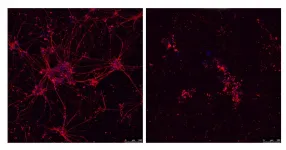(Press-News.org) COLUMBUS, Ohio - Kindergartners from low-income families spent more than six hours a day in front of screens during two early months of the COVID-19 pandemic, a small Ohio study suggests.
That is nearly double the screen time found before the pandemic in similar children, according to other research.
Caregivers from low-income households may have faced more difficulties than those from more advantaged families in managing the time their children spent watching TV and using computers, phones and tablets when child care was shut down, according to the researchers.
Still, the results are concerning, said Rebecca Dore, lead author of the study and senior research associate at The Ohio State University's Crane Center for Early Childhood Research and Policy.
"We found a high level of media use compared to what many experts think is appropriate for this age group," Dore said.
"Some of that time spent using media was positive: watching educational videos and connecting with friends and family. But the amount of time they spent is something we should be aware of."
Dore conducted the research with Ohio State colleagues Kelly Purtell, associate professor of human sciences, and Laura Justice, professor of educational studies and executive director of The Crane Center.
The study was published online recently in the Journal of Developmental & Behavioral Pediatrics.
The study involved 151 low-income caregivers of kindergartners in Ohio who completed online questionnaires between May 1 and June 30, 2020, as part of a larger study.
Caregivers responded to 12 questions assessing children's media use on the most recent weekday and weekend day. Media use included any kind of video, including television, movies or short clips on any electronic device, and using apps or games on any type of device.
Results showed that children averaged 6.6 hours a day of media use. Contrary to previous research, weekday use (6.8 hours) was higher than weekend media use (5.8 hours).
"That suggests parents might have been using media as a substitute for the time their children would have been spending in some type of child care that was closed because of the pandemic," Dore said.
"Increased screen time may be particularly concerning for children from low-income households who had higher levels even before the pandemic: over 3 and a half hours per day compared with less than 2 hours for children from high-income homes."
Remote schooling didn't seem to be the main reason driving the results. Findings showed 84% of children had direct contact with their teachers once a week or less, with 53% reporting no direct contact.
Still, 61% of caregivers reported their child was using media for learning more than usual, perhaps watching educational TV or using educational apps unrelated to formal schooling. Also, 47% reported increased entertainment use, 45% said there was more use as a way to occupy the child's time, 42% reported increased use for maintaining relationships with remote family and friends, and 34% said their child was spending more time using screens for family bonding.
"Importantly, we saw increases in media use in a lot of areas often condidered positive, such as learning and fostering friendships, suggesting that caregivers may have been using media to supplement children's educational and social experiences at a time when in-person options were not safe," Justice said.
"But these families don't have some of the resources that more advantaged families have to help with children while the parents work or do other things. For low-income families, occupying a child's time may also be very important and necessary at times."
Results showed that children living in families with more kids had higher levels of screen time, potentially reflecting the pressures that caregivers have with larger families, Dore said.
Girls in the study spent more time than boys did using media to connect with family and friends. Dore said caregivers should be encouraged to provide more support to boys in maintaining relationships through technology when they can't meet in person.
It is not clear whether the high levels of media use found in this study would also be found in higher-income families.
"Other reports would suggest children from all backgrounds had higher media use during this time," Dore said.
"But use may be even higher in lower-income families because they are less likely to have flexibility to manage children's activities during work hours or be able to afford other child care options."
INFORMATION:
Contact: Rebecca Dore, Dore.13@osu.edu
Laura Justice, Justice.57@osu.edu
Written by Jeff Grabmeier, 614-292-8457; Grabmeier.1@osu.edu
Everyone has at some point been charmed by the sound of a person's voice: but can we believe our ears? What can a voice really reveal about our character? Now an international research team led by the University of Göttingen has shown that people seem to express at least some aspects of their personality with their voice. The researchers discovered that a lower pitched voice is associated with individuals who are more dominant, extrovert and higher in sociosexuality (more interested in casual sex). The findings were true for women as well as for men. The results were published in the Journal of Research in Personality.
The researchers analysed data from over 2,000 participants and included ...
In Amyotrophic Lateral Sclerosis (ALS), the progressive death of neurons that control body movement leads to paralysis of muscles in the limbs and gradually of the whole body, which ultimately makes it impossible to breathe. ALS is currently untreatable, and its cause is unknown.
It is known, however, that in 10% of affected individuals there is a strong genetic component, which causes the disease to occur in several members of a single family. In about half of these cases of familial ALS, the origin lies in a gene called C9ORF72. But why do mutations in this gene kill motor neurons?
The answer may have been found by the Genomic Instability Group headed by Óscar Fernández-Capetillo at the Spanish National Cancer Research Centre (CNIO), who discovered ...
The property that makes fluorescent lights buzz could power a new generation of more efficient computing devices that store data with magnetic fields, rather than electricity.
A team led by University of Michigan researchers has developed a material that's at least twice as "magnetostrictive" and far less costly than other materials in its class. In addition to computing, it could also lead to better magnetic sensors for medical and security devices.
Magnetostriction, which causes the buzz of fluorescent lights and electrical transformers, occurs when a material's shape and magnetic field are linked--that is, a change in shape causes a change in magnetic field. The property could be key to a new generation of computing devices called ...
Trained to see patterns by analyzing thousands of chest X-rays, a computer program predicted with up to 80 percent accuracy which COVID-19 patients would develop life-threatening complications within four days, a new study finds.
Developed by researchers at NYU Grossman School of Medicine, the program used several hundred gigabytes of data gleaned from 5,224 chest X-rays taken from 2,943 seriously ill patients infected with SARS-CoV-2, the virus behind the infections.
The authors of the study, publishing in the journal npj Digital Medicine online May 12, cited the "pressing need" ...
The 'missing link' that helped our ancestors to begin communicating with each other through language may have been iconic sounds, rather than charades-like gestures - giving rise to the unique human power to coin new words describing the world around us, a new study reveals.
It was widely believed that, in order to get the first languages off the ground, our ancestors first needed a way to create novel signals that could be understood by others, relying on visual signs whose form directly resembled the intended meaning.
However, an international research team, led by experts from the University of Birmingham and the Leibniz-Centre General Linguistics (ZAS), Berlin, have discovered that iconic ...
Lancaster scientists have demonstrated that other physicists' recent "discovery" of the field effect in superconductors is nothing but hot electrons after all.
A team of scientists in the Lancaster Physics Department have found new and compelling evidence that the observation of the field effect in superconducting metals by another group can be explained by a simple mechanism involving the injection of the electrons, without the need for novel physics.
Dr Sergey Kafanov, who initiated this experiment, said: "Our results unambiguously refute the claim of the electrostatic field effect ...
Touchscreens are notoriously difficult to type on. Since we can't feel the keys, we rely on the sense of sight to move our fingers to the right places and check for errors, a combination of efforts we can't pull off at the same time. To really understand how people type on touchscreens, researchers at Aalto University and the Finnish Center for Artificial Intelligence (FCAI) have created the first artificial intelligence model that predicts how people move their eyes and fingers while typing.
The AI model can simulate how a human user would type any sentence on any keyboard design. It makes errors, detects them -- though not always immediately -- and corrects them, very much like ...
Philadelphia, May 12, 2021 - The COVID-19 pandemic has resulted in an abrupt change in healthcare delivery, including a shift from in-person visits to telemedicine. However, a Canadian survey found that a significant proportion of cardiology trainees are uncomfortable with using telemedicine and feel that better preparation for new-tech medicine is needed. Experts draw attention to the need for a telemedicine curriculum that includes supervision to prepare trainees for the expanding role of telemedicine in cardiovascular care. Survey results are published in the Canadian Journal of Cardiology.
"Our outpatient care shifted almost overnight from in-person visits to providing care to patients via telephone or video platforms (known as telemedicine) as a result ...
Philadelphia, May 12, 2021 - In recent years there has been an increased interest in the consumption of kefir, a fermented dairy beverage, because there is some evidence that it has health benefits and its affordability. A new study by researchers from the University of Illinois and The Ohio State University, published in JDS Communications, found that 66 percent of the commercial kefir products studied overstated microorganism density and 80 percent contained bacterial species that were not included on the label, potentially misleading consumers.
Senior author Kelly S. Swanson, PhD, University of Illinois, Urbana, ...
A new study led by the Centre for Nutraceuticals in the University of Westminster shows that pink drinks can help to make you run faster and further compared to clear drinks.
The researchers found that a pink drink can increase exercise performance by 4.4 per cent and can also increase a 'feel good' effect which can make exercise seem easier.
The study, published in the journal Frontiers in Nutrition, is the first investigation to assess the effect of drink colour on exercise performance and provides the potential to open a new avenue of future research in the field of sports drinks and exercise.
During the study participants were asked to run on a treadmill for 30 minutes at a self-selected speed ensuring their rate of exertion remained consistent. Throughout the exercise ...




